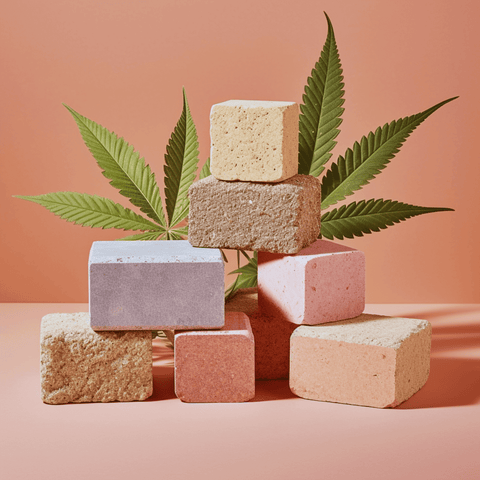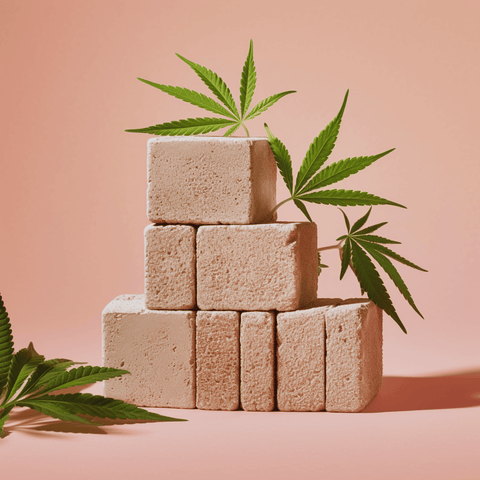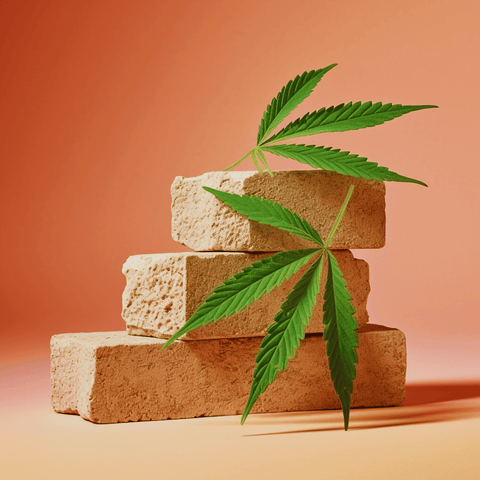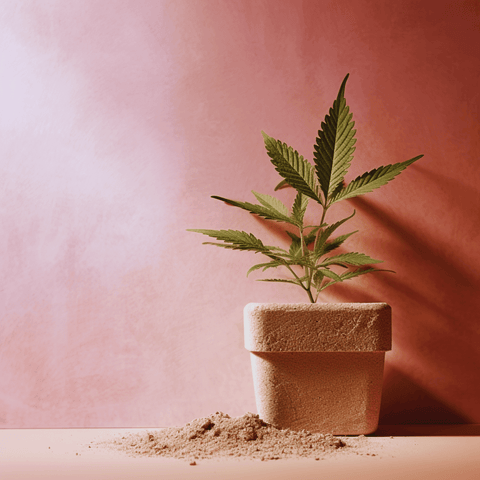Hempcrete: The Sustainable Future of Construction

Hempcrete, as the name suggests, is a bio-composite material that combines hemp, a versatile plant with a history dating back thousands of years, with a lime-based binder to create a natural, sustainable building material.
Hempcrete is a lightweight yet strong, durable construction material with excellent thermal insulating and acoustic properties. It's also breathable, meaning it can absorb and release moisture, helping to regulate indoor air quality and humidity levels. Moreover, Hempcrete is carbon-negative, which absorbs more carbon dioxide during its growth and production than is emitted during its manufacture and application.
The History and Origin of Hempcrete
The use of hemp in construction is a concept that has been introduced previously. It can be traced back to ancient times when hemp fibres were used to create housing materials. However, the modern incarnation of Hempcrete originated in France in the 1980s. During this time, builders began combining hemp shiv (the woody core of the hemp plant) with lime to create a natural, sustainable building material. Since then, Hempcrete has spread globally, gaining recognition for its environmental benefits and unique properties.
Understanding the Composition of Hempcrete
Hempcrete is a unique bio-composite material that combines the natural strength and durability of hemp with the binding properties of lime. The result is a lightweight yet robust construction material with many beneficial properties.
The Basic Recipe of Hempcrete: Lime, Hemp, and Water
The primary ingredients in Hempcrete are hemp shiv, lime binder, and water. Hemp shiv, the woody core of the hemp plant, makes up the bulk of the mixture. The lime binder, typically composed of natural hydraulic lime and lime putty, acts as the 'glue' that holds the hemp shiv together. Water is used to initiate the chemical reaction that sets the lime binder.
Hempcrete's typical ratio of hemp to lime is about 3:1 by volume, but this can vary depending on the product's specific application and desired properties. The mixture is combined and then cast into forms or sprayed onto surfaces, where it hardens into a solid, stone-like material.
The Role of Each Component in the Mixture
Each component in Hempcrete plays a crucial role. The hemp shiv provides the bulk of the material and contributes to Hempcrete's excellent thermal insulation properties. It's also responsible for the material's breathability, which helps regulate indoor humidity levels.
The lime binder, on the other hand, provides the structural strength and durability of Hempcrete. Lime is a natural material used in construction for thousands of years. Hempcrete binds the hemp shiv together and hardens over time, resulting in a solid, robust material.
Water initiates the chemical reaction that sets the lime binder. As the Hempcrete dries, the water evaporates, leaving a solid, stone-like material behind. The drying process also allows the lime to absorb carbon dioxide from the air, contributing to Hempcrete's carbon-negative status.
The Process of Making Hempcrete

Creating Hempcrete is a relatively straightforward process that involves mixing hemp shiv, lime binder, and water. Despite its simplicity, the process requires careful attention to detail to ensure the final product has the desired properties.
The Step-by-Step Process of Creating Hempcrete
The first step in creating Hempcrete is to prepare the hemp shiv, which involves removing the outer fibrous layer of the hemp stalks and then shredding the inner woody core into small pieces.
Next, the lime binder is prepared by mixing natural hydraulic lime and lime putty to create a binder that effectively adheres to the hemp shiv.
Once the hemp shiv and lime binder are prepared, they are blended in a large drum mixer. Water is then added to the mixture to initiate the chemical reaction that sets the lime binder. The mixture is thoroughly mixed until it reaches a consistency similar to wet concrete.
The wet Hempcrete is then cast into forms or sprayed onto surfaces, tamped down to remove air pockets and ensure a solid, uniform material. The Hempcrete is then left to dry, a process that can take several weeks depending on the thickness of the Hempcrete and the local climate.
The Equipment and Materials Needed
The primary materials needed to make Hempcrete are hemp shiv, lime binder, and water. In terms of equipment, a large drum mixer is typically used to mix the Hempcrete.
Wooden forms are often used for casting the Hempcrete, similar to those used in concrete construction. For spray applications, a specialised Hempcrete sprayer can be used. Other tools, such as tampers and screeds, compact and level the Hempcrete.
Hempcrete is a bio-composite material with many benefits, from environmental to structural and health advantages. Its unique properties make it an excellent choice for sustainable and healthy construction.
Environmental Benefits: Carbon Storage, Low Embodied Energy
One of the most significant environmental benefits of Hempcrete is its ability to store carbon. The hemp plant absorbs carbon dioxide as it grows, and this carbon remains locked in the Hempcrete, effectively making it a carbon-negative material. This ability to sequester carbon can help reduce the overall carbon footprint of a building project.
Additionally, Hempcrete has low embodied energy, requiring less energy than traditional building materials. The hemp plant grows quickly and does not require synthetic fertilisers or pesticides, further reducing the environmental impact of Hempcrete production.
Structural Benefits: Fire and Flood Resistance, Thermal Insulation, Breathability
Hempcrete also offers several structural benefits. It is naturally fire and flood-resistant, making it a safe choice for construction. Moreover, its excellent thermal insulation properties can help reduce energy consumption for heating and cooling, contributing to the energy efficiency of a building.
Furthermore, Hempcrete is a breathable material. It can absorb and release moisture, helping regulate indoor humidity levels and prevent condensation, leading to structural damage over time.
Health Benefits: Resistance to Mold and Pests, Improved Air Quality
The health benefits of Hempcrete are also noteworthy. Its resistance to mould and pests can contribute to a healthier indoor environment, reducing potential allergens and irritants. Moreover, the breathability of Hempcrete can improve indoor air quality by regulating humidity and preventing the buildup of moisture, which can lead to mould growth.
In addition, Hempcrete does not emit volatile organic compounds (VOCs), often associated with synthetic building materials and can have adverse health effects.
Applications of Hempcrete

Hempcrete's unique properties make it a versatile material with many applications in the construction industry and beyond.
Use in Building Construction: Walls, Roofs, Floors
One of the primary uses of Hempcrete is in building construction, where it can be used to construct walls, roofs, and floors. Hempcrete walls provide superb thermal insulation and breathability, helping to create a comfortable indoor environment with stable temperatures and humidity levels.
Hempcrete can also be used in roofs and floors, providing insulation and adding to the overall energy efficiency of the building. Its lightweight nature makes it an excellent choice for these applications, reducing the load on the building's structure compared to traditional materials.
Other Potential Uses of Hempcrete
Beyond its use in building construction, Hempcrete has the potential for various other applications. Its fire resistance makes it a potential material for fireproofing and insulation in high-risk areas. Meanwhile, its sound-absorbing properties are useful in acoustic insulation for walls and ceilings.
In addition, Hempcrete's resistance to pests and mould could make it a suitable material for use in agricultural buildings, where these issues can be prevalent. Its breathability and ability to regulate humidity make it an attractive option for storage facilities, particularly for goods sensitive to moisture and temperature changes.
Furthermore, as Hempcrete ages, it petrifies and strengthens, making it a potential material for long-term, sustainable construction projects.
Hempcrete vs. Traditional Building Materials
When considering the use of Hempcrete, it's essential to understand how it compares to traditional building materials like concrete and wood. Each material has its unique properties, advantages, and disadvantages.
Comparing the Properties of Hempcrete with Traditional Building Materials
Hempcrete, concrete, and wood all have distinct properties that influence their performance as building materials. Hempcrete is lightweight, breathable, and has excellent thermal and acoustic insulation properties. It's also resistant to fire, pests, and mould, and it's a carbon-negative material.
Concrete, on the other hand, is a highly durable material with excellent compressive strength. However, it's not breathable, has lower insulation properties, and its production is energy-intensive and emits significant carbon dioxide.
Wood is a natural material that's renewable and has good insulation properties. However, it's susceptible to pests, fire, and rot, requiring maintenance to preserve its condition over time.
Discussing the Advantages and Disadvantages of Each
Hempcrete's main advantages lie in its environmental benefits, insulation properties, and resistance to fire, pests, and mould. However, it has lower compressive strength than concrete and requires a longer drying time.
Concrete's strength and durability are its main advantages. It is resistant to pests and rot and has a shorter drying time than Hempcrete. However, it isn't a renewable resource, and its production has a high environmental impact.
Wood is renewable and has a lower environmental impact than concrete. It also has a faster drying time than Hempcrete. However, it's susceptible to pests, fire, and rot and requires regular maintenance.
Economic Implications of Using Hempcrete
Using Hempcrete in construction has several economic implications, both in terms of initial costs and long-term savings. Understanding these can help builders and homeowners make informed decisions about their construction materials.
Analysis of the Cost of Using Hempcrete Compared to Other Building Materials
The initial cost of using Hempcrete can be higher than traditional building materials like concrete and wood due to the specialised nature of Hempcrete production and the current relatively low demand for hemp as a construction material.
However, it's important to consider that the cost of building materials is only one part of the total construction cost. Labour costs, for example, can be lower with Hempcrete due to its ease of use and the simplicity of the construction process. Additionally, the cost of Hempcrete is likely to decrease as demand increases and more suppliers enter the market.
Discussion on the Long-Term Savings Due to Hempcrete's Insulating Properties and Durability
While the initial cost of Hempcrete may be higher, its insulating properties and durability can lead to significant long-term savings. Hempcrete's excellent thermal insulation can reduce energy costs for heating and cooling, leading to lower utility bills over the life of the building.
Furthermore, Hempcrete's durability and resistance to pests, mould, and fire can reduce maintenance and repair costs. Its breathability can also contribute to a healthier indoor environment, potentially reducing healthcare costs.
Hempcrete and Sustainability

Sustainability is a critical concern in the construction industry, and Hempcrete is a material that significantly contributes to sustainable construction practices. Its role in green building certifications further underscores its sustainability credentials.
Detailed Look at How Hempcrete Contributes to Sustainable Construction
Hempcrete production is less energy-intensive than traditional building materials, resulting in lower embodied energy. Furthermore, Hempcrete is fully recyclable at the end of its life, either as a soil amendment or as a raw material for new Hempcrete.
Hempcrete's excellent thermal insulation properties can reduce energy consumption for heating and cooling, contributing to lower greenhouse gas emissions. Its breathability also contributes to a healthier indoor environment, promoting the well-being of occupants.
The Role of Hempcrete in Green Building Certifications
Hempcrete can contribute to achieving green building certifications, such as LEED (Leadership in Energy and Environmental Design) and BREEAM (Building Research Establishment Environmental Assessment Method). These certifications recognise buildings that incorporate sustainable practices and materials.
Hempcrete can contribute points in several categories, including energy efficiency, materials and resources, and indoor environmental quality. Its use of a renewable resource (hemp), low embodied energy, and contribution to a healthy indoor environment are all recognised in these certifications.
Innovations and Advances in Hempcrete Technology

As the demand for sustainable building materials grows, so does the innovation in Hempcrete technology. Recent advancements have made the production and application of Hempcrete more efficient and versatile.
Overview of Recent Technological Advances in the Production and Application of Hempcrete
One of the significant advancements in production has been the development of more efficient hemp processing techniques. These techniques allow for the extraction of hemp shiv more quickly and cost-effectively, reducing the overall cost of Hempcrete.
Another advancement is the development of improved lime binders. These new binders set faster and provide greater strength, improving the structural performance of Hempcrete. Some of these binders also incorporate other sustainable materials, such as recycled fly ash, further enhancing the environmental credentials of Hempcrete.
In terms of application, one of the most significant advancements has been the development of Hempcrete spray systems. These systems allow for the rapid application of Hempcrete, reducing construction time and labour costs. They also enable the application of Hempcrete in a wider range of situations, including retrofitting existing buildings.
Another exciting development is the creation of Hempcrete blocks and panels. These pre-fabricated products can be produced off-site and quickly assembled on-site, reducing construction time. They also provide greater consistency and quality control compared to site-mixed Hempcrete.
Challenges and Controversies Surrounding Hempcrete
While Hempcrete offers many benefits, it has its challenges and controversies. Considering these aspects, from regulatory issues to potential drawbacks, is important when evaluating Hempcrete as a building material.
Regulatory Issues and Legal Aspects
One of the main challenges facing Hempcrete is regulatory issues. Although hemp is now legal to grow in many countries, including Australia, it's still heavily regulated. These regulations can make it more difficult and costly to grow and process hemp, increasing the cost of Hempcrete.
Furthermore, building codes and standards in many areas still need to be updated to include Hempcrete, making it more challenging to get approval for Hempcrete construction projects.
Limitations and Potential Drawbacks of Hempcrete
While Hempcrete has many advantages, it also has some limitations. One of the main drawbacks is its lower compressive strength compared to traditional building materials like concrete. Hempcrete can only be used for load-bearing structures with additional support.
Another potential drawback is the longer drying time of Hempcrete. This can extend the construction timeline, increasing costs and making Hempcrete less suitable for projects with tight schedules.
Finally, while Hempcrete is resistant to pests and mould, it can be susceptible to damage if it's not properly protected from prolonged exposure to water, meaning that Hempcrete structures must be well-designed to prevent water intrusion.
The Future of Hempcrete

As the construction industry continues to evolve towards more sustainable practices, Hempcrete is poised to play a significant role in this transformation.
Current Trends in Hempcrete Use
Currently, we're seeing an increasing interest in Hempcrete across the globe. More builders and homeowners recognise its environmental benefits and unique properties, leading to a rise in its use in residential and commercial construction. Furthermore, developing Hempcrete products, such as pre-fabricated blocks and panels, makes it more accessible and easier to use.
Predictions for the Future of Hempcrete in Construction
Looking ahead, the future of Hempcrete in construction appears promising. As more research is conducted and technology advances, we can expect to see improvements in the production and application of Hempcrete, making it even more efficient and versatile.
Furthermore, as regulations evolve and green building certifications continue to gain importance, Hempcrete will likely become an increasingly popular choice for sustainable construction. Its carbon-negative status makes it an attractive option for builders and homeowners seeking to reduce their environmental impact.
The Versatility of Hemp: Beyond Hempcrete
While Hempcrete is a great application of hemp in the construction industry, the versatility of this plant extends far beyond. Hemp has been cultivated for centuries for its fibre, seed, and oil, which have been used to produce a wide range of products.
Hemp Fibre
Hemp fibre is one of the strongest and most durable natural textile fibres. This makes it an excellent material for making various products, including clothing, bags, ropes, and paper. The fibre is also used in the automotive industry to make bioplastics and composite materials for car interiors.
Hemp Seed and Oil
Hemp seeds are highly nutritious and can be consumed raw, cooked, or roasted. They are rich in protein, fibre, and healthful fatty acids, including omega-3s and omega-6s. Hemp seed oil, which is cold-pressed from the seeds, has a variety of culinary and industrial uses. It can be used in cooking and baking, as a dietary supplement, and in producing soaps, lotions, and other personal care products.
CBD Extraction
In recent years, hemp has gained attention for its potential in the production of cannabidiol (CBD), a non-psychoactive compound that has been linked to a range of health benefits. CBD can be extracted from certain hemp varieties' flowers and leaves and used in various products, from dietary supplements to therapeutic oils and creams.
Animal Bedding
Hemp shiv, the woody core of the hemp stalk, is highly absorbent and naturally resistant to pests. It is an excellent material for animal bedding, particularly for horses and small pets like rabbits and guinea pigs.
Conclusion
In this article, we've explored the many facets of Hempcrete, from its composition and production to its benefits, applications, and prospects. Despite some challenges, Hempcrete is a sustainable, versatile, and health-conscious building material. Its unique properties, including excellent thermal insulation, breathability, and carbon storage, make it a compelling choice for sustainable construction. As we move towards a more environmentally conscious future, Hempcrete offers a promising solution for reducing the environmental impact of our buildings. We encourage builders and homeowners to consider Hempcrete for sustainable, healthy, and resilient homes and buildings.





